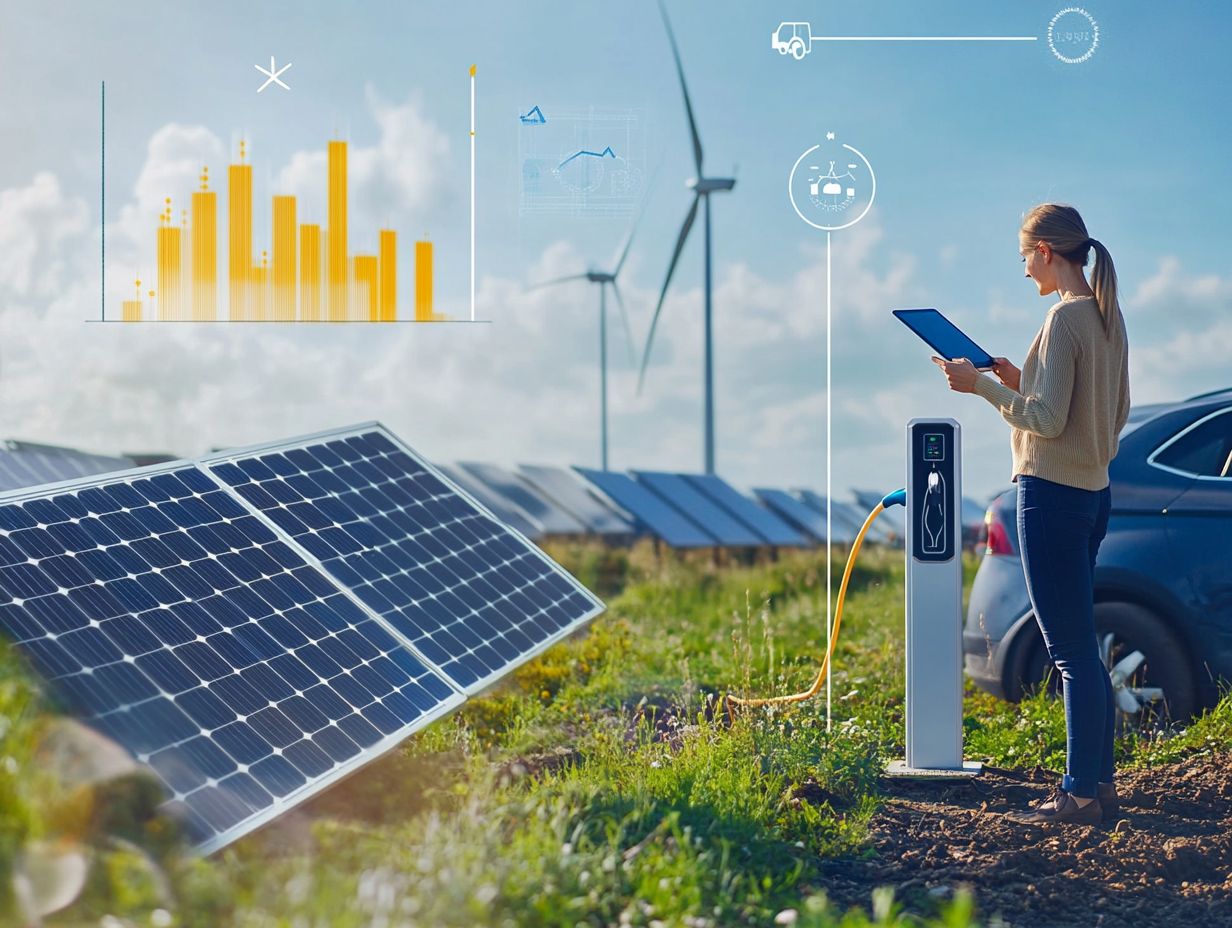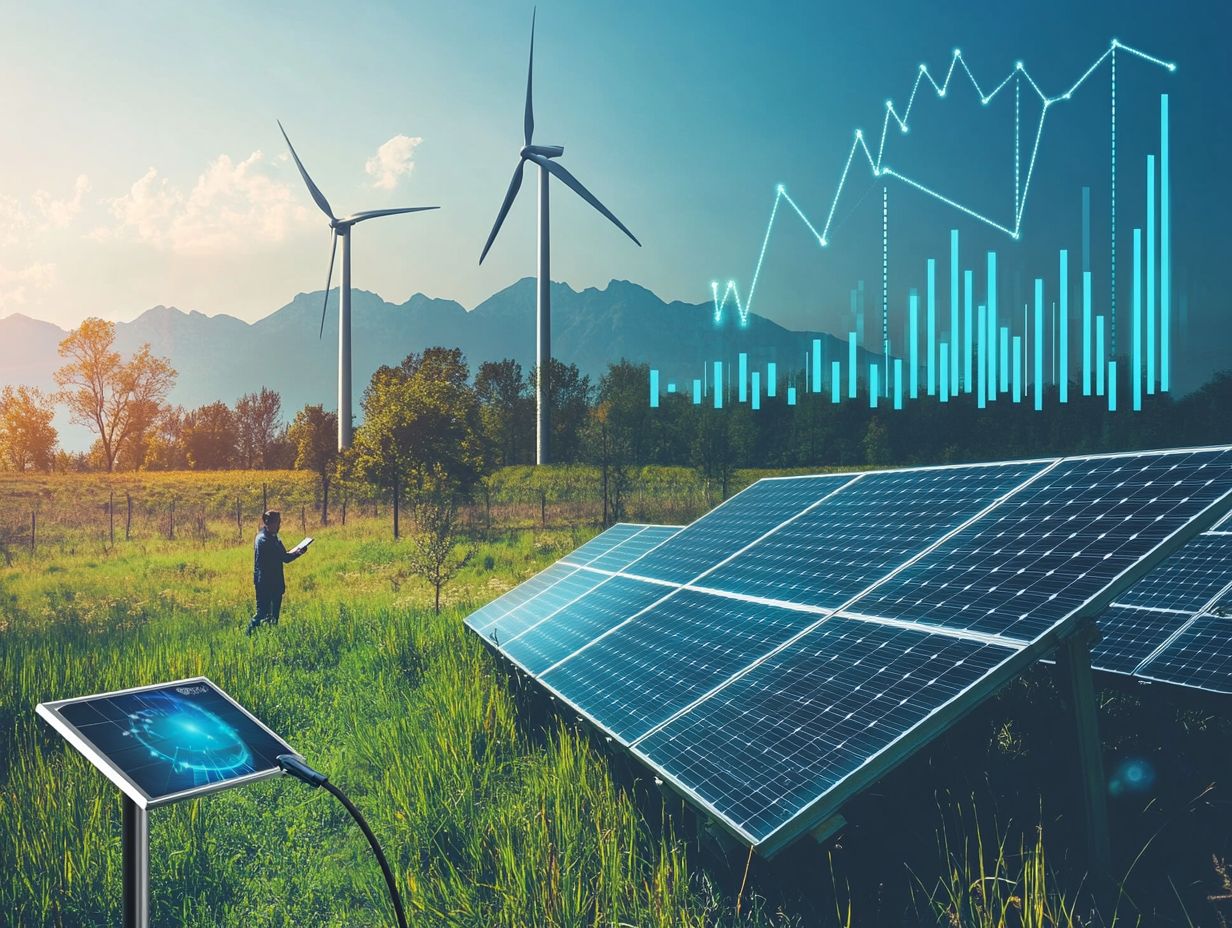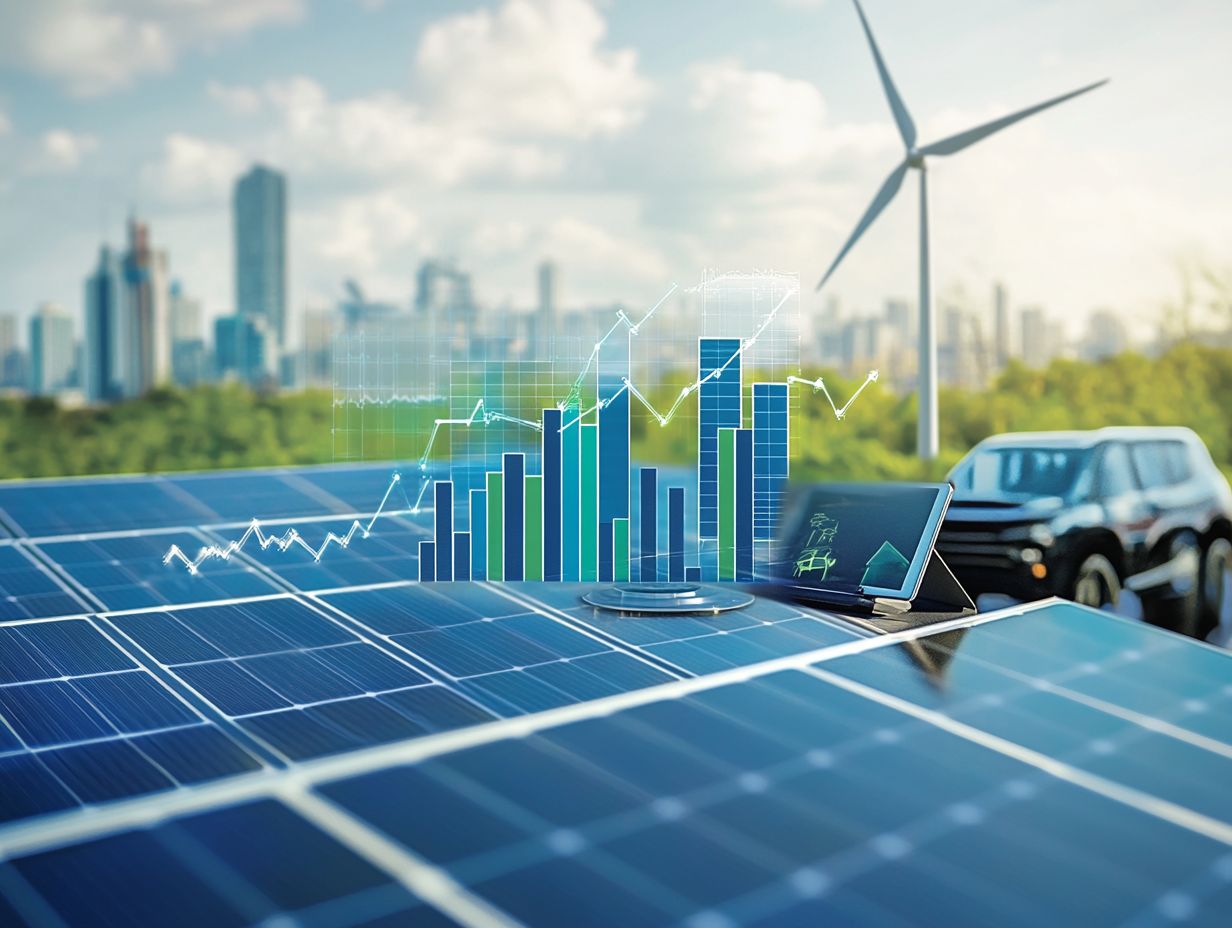5 Market Trends in the Energy Sector
The energy sector is buzzing with a surge in renewable energy sources, all fueled by the urgent necessity to tackle climate change and cater to sustainability demands. This shift underscores the significance of clean energy technologies (clean energy technologies include sources like solar power, wind energy, and hydrogen) in the global transition towards a carbon-free economy (a carbon-free economy aims to eliminate carbon emissions).
As solar panels grow increasingly affordable and efficient, you’re likely to see them adorning rooftops and sprawling across solar farms. These installations generate clean electricity that seamlessly integrates into existing grids. Wind turbines, whether onshore or offshore, expertly capture natural breezes to produce substantial energy outputs, playing a pivotal role in national energy strategies.
Hydrogen is emerging as a versatile energy carrier, facilitating storage and transport that effectively smooths out the inherent variability of solar and wind generation. These technologies bolster energy security and play an essential role in curbing carbon emissions, paving the way for a sustainable energy future that aligns with global climate objectives.
Contents
- 2. Growth of Smart Grid Technology
- 3. Shift Towards Electric Vehicles
- Key Takeaways:
- 4. Emphasis on Energy Storage Solutions
- 5. Integration of Artificial Intelligence and Big Data
- What Are the Main Drivers of These Trends?
- How Are Government Policies and Regulations Impacting the Energy Sector?
- What Role Do Consumers Play in Shaping These Trends?
- How Are Companies Adapting to These Changes?
- What Are the Potential Challenges and Risks Associated with These Trends?
- What Are the Future Implications of These Trends for the Energy Sector?
- Frequently Asked Questions
- What are the top 5 market trends reshaping the energy sector?
- What is the impact of renewable energy on the energy sector?
- Why is energy storage gaining popularity in the energy sector?
- How does energy efficiency play a role in the energy sector?
- What is the impact of electrification on the energy sector?
- How is digitalization changing the energy sector?
2. Growth of Smart Grid Technology
The rise of smart grid technology is revolutionizing the energy sector, elevating energy management through digitalization and the integration of IoT devices (IoT stands for Internet of Things). This evolution leads to enhanced operational and energy efficiency in grid operations.
With this innovative framework, you can monitor your energy consumption in real-time, empowering you to make informed decisions about your usage patterns. It streamlines energy distribution by ensuring that resources are allocated more effectively, minimizing waste and boosting reliability.
The smart grid’s capacity to integrate distributed energy resources cultivates a decentralized energy model, enabling you and your community to generate, store, and share energy. These advancements optimize your energy usage and strengthen the resilience of the entire infrastructure, making it more adaptable to fluctuations and potential disruptions.
3. Shift Towards Electric Vehicles
The shift toward electric vehicles is transforming energy consumption patterns, aligning with sustainability demands and decarbonization strategies (decarbonization strategies aim to reduce carbon emissions) that aim to reduce carbon emissions while fostering economic growth and job opportunities in the energy sector.
This transformation reflects a change in consumer preferences and drives significant investments in infrastructure development. Charging networks are rapidly expanding, thanks to government incentives and policies designed to promote cleaner transportation. As a result, these initiatives help lower greenhouse gas emissions, given that electric vehicles operate more efficiently than their internal combustion counterparts.
Technological advancements in battery life and charging times are enhancing the appeal of electric vehicles, further accelerating their adoption across various markets and reinforcing the commitment to a sustainable future.
Key Takeaways:
- Renewable energy sources are on the rise, making up a larger portion of the energy sector.
- Smart grid technology is growing, allowing for more efficient energy distribution.
- The energy sector is shifting towards electric vehicles, reducing reliance on fossil fuels.
Dive into the thrilling future of energy now!
4. Emphasis on Energy Storage Solutions

You ll notice an increasing focus on energy storage solutions, particularly lithium-ion batteries. These are important for improving energy efficiency and integrating renewable energy into grid operations.
However, the realm of energy storage isn’t limited to just lithium-ion technology. Various systems, such as pumped hydro storage (a method of storing energy by using water), flywheels, and the promising solid-state batteries, present distinct advantages. They stabilize energy supply and address the intermittency associated with wind and solar power.
These technologies act as a buffer against grid fluctuations. They also help optimize energy consumption patterns, making them essential for your journey towards a greener energy economy.
Despite advancements, challenges like cost, scalability, and resource availability remain. This ongoing struggle fuels research and development in the energy sector, driving the quest to unlock their full potential and foster sustainable solutions.
5. Integration of Artificial Intelligence and Big Data
The integration of artificial intelligence and big data within the energy sector is sparking a wave of technological innovation. This significantly enhances energy management, leading to improved operational efficiency and more informed decision-making processes.
This paradigm shift allows you to harness advanced algorithms and predictive models, giving you the power to anticipate demand fluctuations and manage resources effectively. By leveraging machine learning techniques, you can adopt predictive maintenance strategies that identify potential equipment failures before they occur, ultimately reducing downtime and lowering maintenance costs.
Data-driven insights help you optimize energy production. This not only maximizes output but also supports your sustainability goals. As big data analytics continues to evolve, it transforms raw data into actionable strategies, enabling energy systems to enhance their performance while minimizing waste and championing greener practices.
What Are the Main Drivers of These Trends?
Several key drivers are shaping transformative trends in the energy sector. These include technological innovation, sustainability-focused policy changes, and rising consumer engagement in energy trading. Together, these factors enhance economic growth and meet sustainability demands.
As technology advances especially in renewable energy sources and smart grid systems you transition from a passive consumer to an active participant in the energy landscape. This dynamic shift encourages a greater reliance on decentralized energy systems and alternative solutions, giving you and your community the power to tap into local resources with ease.
Simultaneously, government policies are stepping up to support these transitions through incentives, regulations, and funding for clean technologies. The interplay between these advancements and supportive policies fosters innovation and cultivates a more informed consumer base eager to engage in energy efficiency and sustainability efforts.
How Are Government Policies and Regulations Impacting the Energy Sector?
Government policies are shaping the future of the energy sector and making renewable technologies exciting and accessible! They influence your adoption of renewable energy technologies and drive sustainability demands through various regulatory changes and incentives.
For instance, subsidies for renewable energy sources like solar and wind significantly lower the initial investment hurdles. This makes clean technology much more accessible. Stringent emissions targets compel you to innovate and adopt sustainable practices, aligning your operations with global environmental goals.
Energy efficiency standards ensure that new buildings and infrastructure are designed with sustainability in mind. Collectively, these strategies are essential for a fast and effective transition to a greener energy landscape, positioning economies for yours included for enhanced resilience against climate change. This benefits both you and future generations.
What Role Do Consumers Play in Shaping These Trends?

You play a pivotal role in shaping trends within the energy sector, especially through consumer energy trading. This gives you the power to manage your energy consumption in alignment with sustainability demands.
This shift reflects a growing awareness of environmental issues. It drives you to seek out cleaner and more efficient energy options. Thanks to advancements in technology, you’re now able to track your usage patterns. You can make choices that not only save you money but also contribute to a greener future.
As a consequence, the demand for renewable energy sources is on the rise. This prompts utilities and providers to adapt to your evolving preferences.
These new trading platforms facilitate direct exchanges between consumers. This allows you to buy and sell excess energy, fostering a more decentralized energy market where sustainability becomes a collective priority.
How Are Companies Adapting to These Changes?
Companies in the energy sector are swiftly adapting to changing dynamics. They are harnessing technological innovation, enhancing energy management practices, and making big investments in strong energy trading platforms.
This adaptation demonstrates a proactive response to regulatory changes and market volatility. It also highlights a commitment to sustainable practices. You will see companies teaming up with technology firms to integrate technology that helps computers learn from data for more precise demand forecasting.
Many companies are forming strategic partnerships with renewable energy providers to diversify their portfolios and minimize their carbon footprints.
A prime example lies in the alliances formed by established oil companies with solar startups. These collaborations facilitate a smoother transition to greener energy sources while ensuring competitiveness in an ever-evolving market.
What Are the Potential Challenges and Risks Associated with These Trends?
The evolving trends in the energy sector bring a wealth of opportunities. Yet, they also introduce potential challenges and risks that you need to navigate.
Rapid technological advancements and shifting policies can significantly impact existing energy systems and carbon emissions.
Among these challenges, regulatory hurdles often stand out as formidable roadblocks. They complicate your ability to adapt to new rules and standards in a timely manner. Market volatility adds another layer of complexity, with fluctuating prices influencing your investment decisions and the viability of projects.
Technological risks, such as cybersecurity threats and system failures, can further undermine the reliability of energy systems you rely on.
Each of these challenges carries critical implications for broader sustainability and decarbonization goals. They could potentially hinder your transition to cleaner energy solutions and slow progress toward achieving climate targets.
What Are the Future Implications of These Trends for the Energy Sector?
Exciting changes are ahead! These trends will transform the energy sector dramatically.
As technological innovation merges with a commitment to sustainability, energy production, consumption, and management will be redefined, ultimately fueling economic growth.
In the years ahead, you will witness the seamless integration of technology that helps computers learn from data and machine learning to optimize energy grids and enhance efficiency.
This technological evolution is set to foster more decentralized energy systems. It will give you the power to generate your own energy from renewable sources and sell any surplus back to the grid.
As governments increasingly focus on climate initiatives, you can expect regulatory frameworks to adapt, incentivizing investments in clean energy technologies.
Enhanced collaborations between public and private sectors may pave the way for groundbreaking research in battery storage and carbon capture solutions. This could fundamentally transform your relationship with energy reliance and efficiency.
Frequently Asked Questions

What are the top 5 market trends reshaping the energy sector?
Let s dive into the exciting top 5 market trends reshaping the energy sector: renewable energy, energy storage, energy efficiency, electrification, and digitalization.
What is the impact of renewable energy on the energy sector?
Renewable energy is significantly impacting the energy sector by increasing competition and driving down costs. It also helps reduce dependency on fossil fuels.
Why is energy storage gaining popularity in the energy sector?
Energy storage is gaining popularity because it enables better integration of renewable energy sources. It also helps manage high electricity use times and improves reliability.
How does energy efficiency play a role in the energy sector?
Energy efficiency is a crucial trend as it reduces energy waste and lowers costs for consumers. This trend is vital for our future, as it also helps reduce carbon emissions.
What is the impact of electrification on the energy sector?
Electrification, which means using electricity instead of oil or gas, is a growing trend due to its environmental benefits. This transition has the potential for increased energy efficiency.
How is digitalization changing the energy sector?
Digitalization is transforming the energy sector by enabling better monitoring, control, and optimization of energy systems. These advancements lead to increased efficiency and cost savings.





